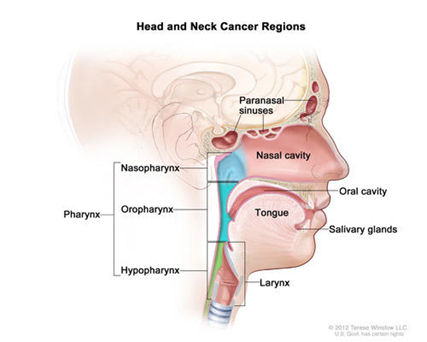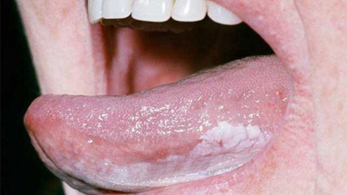This HDScan app is developed for detection of tongue cancer and help you to get an early pre-diagnosis of cancer.
About tongue cancer
Tongue cancer is a cancer of the tongue and is the most common type of cancer in the mouth. Oral cancer is a cancer that develops in the tongue, gums, upper jaw, and cheek mucosa. There are two types of tongue cancer: oral tongue cancer, which is cancer that occurs in the front two-thirds of the tongue, and cancer in the base of the tongue, the back third located in the throat or oropharynx which is classified as head and neck cancer (oropharyngeal cancer). Several types of cancer grow in the tongue but squamous cell carcinoma is the most common. Cancer cells spread deeper into the tissue of the tongue as the tumor grows.

Head and neck cancer regions. Illustrates location of paranasal sinuses, nasal cavity, oral cavity, tongue, salivary glands, larynx, and pharynx (including the nasopharynx, oropharynx, and hypopharynx).
Credit: © Terese Winslow
https://www.cancer.gov/types/head-and-neck/head-neck-fact-sheet
Risk factors for oral cancer include smoking or using tobacco products, heavy alcohol consumption and HPV infections. Oral cancer can occur at any age, but people over the age of 45 are at higher risk. People who are over the age of 60 have the highest incidence, although oral cancer may be found in people under 40. It is twice as common in men.
Tongue cancer is relatively rare. It’s estimated that 2,900 men and 1,400 women will be diagnosed with oral cancer each year in Canada. According to the National Cancer Institute (NCI) (https://seer.cancer.gov/statfacts/html), tongue cancer represents 0.9% of all new cancer cases in the U.S. In 2022, it is estimated that there will be 17,860 new cases of tongue cancer and an estimated 2,790 people will die of this disease. Using statistical models for analysis, age-adjusted rates for new tongue cancer cases have been rising on average 2.2% each year over 2010–2019. Oral cavity and pharynx cancer represents 2.8% of all new cancer cases in the U.S. In 2022, it is estimated that there will be 54,000 new cases of oral cavity and pharynx cancer and an estimated 11,230 people will die of this disease. Using statistical models for analysis, age-adjusted rates for new oral cavity and pharynx cancer cases have been rising on average 1.0% each year over 2010–2019.
Cancer stage at diagnosis determines treatment options and has a strong influence on the survival length. If the cancer is found only in the part of the body where it started, the stage is localized (confined to primary site). If it has spread to a different part of the body, the stage is regional (spread to regional lymph nodes) or distant (cancer has metastasized). Based on data from the NCI, SEER17 2012–2018 (https://seer.cancer.gov/statfacts/html), for tongue cancer, 29% are diagnosed at the local stage, 53% at regional and 15% at distant stage. The 5-year relative survival rate is 84.2% for localized, 69.8% for regional and 40.7% for distant, with a combined rate of 68.8% for all stages. For oropharyngeal cancer, the American Cancer Society reports the 5-year relative survival rate as 59% for localized, 59% for regional and 28% for distant, with a combined rate of 50% for all stages between 2011 and 2017 (https://www.cancer.org/cancer/oral-cavity-and-oropharyngeal-cancer). In general, early diagnosis and treatment lead to better outcomes.
Subjective symptoms include a hard lump and sores on the tongue, but pain and bleeding are not always present. Symptoms such as discomfort with tongue movement, numbness of the tongue, red spots (erythroplakia) and white spots (leukoplakia) on the mucous membrane of the tongue, and stomatitis or a lump that is difficult to heal for more than two weeks may be observed (Fig.). Symptoms of advanced cancer include persistent pain, bleeding, and bad breath.
Fig. Tongue cancer (Source: www.kaggle.com)

When oral cancer is found and treated early, the chances of successful treatment are better. Get regular health checkups and see your dentist or doctor if you have:
- White or red patch on the tongue
- Sore and/or a lump in the mouth that doesn’t heal for more than 2 weeks
- Persistent discomfort or pain in the tongue
- Numbness or burning sensation in the tongue
- Bleeding in the mouth
- Lump in the neck (cancer can spread to the lymph nodes in the neck)
- Difficulty swallowing or chewing
- Difficulty moving tongue or jaw
- Loose teeth or dentures that no longer fit
- Weight loss and/or fatigue
- Bad breath
Tongue cancer is treated with surgery, radiation, or chemotherapy, depending on the type and stage of the disease. In early stages, tongue cancer can be treated by surgical removal or radiation therapy. Cases in more advanced stages may have surgery followed by radiation therapy and chemotherapy.
Oral tongue cancer is a cancer that allows you to see the affected area yourself using a mirror. They are often found on the sides of the tongue and are less common on the tip or central part of the tongue surface. They can also occur in hard-to-see areas, such as the back of the tongue.
If you have any worrisome symptoms,
Check your tongue with HDScan app!
And see your doctor in-person as soon as possible!
